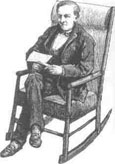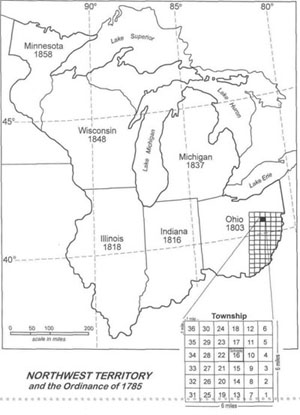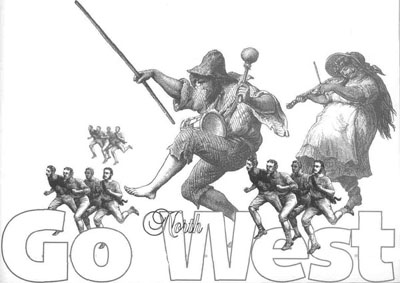C U R R I C U L U M M A T E R I A L S
|
Shayne Klein and Fred R. Williams
Overview
Main Ideas
The Confederation Congress passed the
Northwest Ordinance in 1787 to encourage
western migration. Powerful land companies
made western expansion a business venture. Speculators purchased cheap lands
that they hoped to sell at a high profit. To
lure settlers, territorial leaders developed a
political framework to protect liberty and
property. They secured for settlers in the
West religious freedom, protection against
cruel and unusual punishment, and a government unable to seize land for the public
good without first offering the owner just
compensation. The Ordinance of 1787 also
prohibited slavery. However, its framers
compromised with slaveholders when they
6
approved a fugitive slave law to force the
return of runaway slaves. A controversy surfaced over how to apply Article 6, which both
banned and enforced slavery. Leaders in the
territory, however, successfully made the
article a gradual emancipation law.
Connection with the Curriculum
The Northwest Territory is appropriate
for studying American history at the national
and state level and for examining critical
issues in civics and government.
Teaching Level
Grades 9-12
Materials for Each Student
• The narrative portion of this article
• Maps and activity pages
• Selections from the Ordinance of 1787
Objectives for Each Student
• Identify the physical boundaries of
Illinois and the Northwest Territory.
• Identify in the Northwest Ordinance
and the Constitution the clauses
that secured slavery.
• List three reasons why Americans
immigrated to the Northwest Territory.
• Describe the debate over slavery and
freedom in the Northwest Territory.
• Explain why the Ordinance of 1787
did not successfully abolish slavery.
• Discuss the arguments of historians
regarding Article 6's capacity to
eliminate slavery.
• Explain how making Article 6 a
gradual emancipation law formed
the basis for the black laws of Illinois.
SUGGESTIONS FOR
TEACHING THE LESSON
|
Opening the Lesson
Slavery and expansion are two dominant themes in early American history. Have
students brainstorm about what they already
know about the introduction and spread of
slavery up to 1800. Then ask the students to
consider the reasons why people would
choose to move out of one of the original
thirteen states and settle in the West, a
place that was little developed by European
settlers.
Be sure to read the narrative portion of
the article with your students and discuss it
with them to ensure their understanding of
the contents. Next, have students brainstorm
about the origins of Illinois. Finally, have students make the connection between expansion, the Northwest Ordinance, and the slavery debate.
Developing the Lesson
• Help students understand the
geography and population of
the Northwest Territory.
• Have students review critical
documents such as the Ordinance
of 1787, the Constitution of the United
States, and the Constitution of Illinois.
• Have students role play, explaining
why they would immigrate from the
North or South. Would their origins
influence their opinion on slavery in
Illinois, on Jefferson's antislavery
proposal, or on Article 6?
• Is there a critical difference in the
antislavery bill that Jefferson
proposed in 1784 and in what
Congress approved in 1787?
Concluding the Lesson
• Have students explain the
long-range consequences of the
initial interpretation of Article
6, especially during the first
twenty years after Illinois
entered the Union.
• Have students consider whether national
policy influences society and culture at the
local level.
Extending the Lesson
• For advanced students in
American history, the Northwest
Ordinance provides a means to
assess the frontier thesis of
Frederick Jackson Turner. The
Turner thesis, in part, contends
that American culture and political
ideology developed in the West and
then migrated back to the East. The
Northwest Ordinance predated both
the Constitution and the Bill of Rights,
yet contains many of their provisions.
Do the various provisions of the
Northwest Ordinance lend support
to Turner's thesis?
Assessing the Lesson
• Teachers can assess learning through
student responses to the guided questions provided in activities that follow.
7

The states of Illinois, Wisconsin, Michigan, Indiana, and Ohio and parts of Minnesota were
formed from the Northwest Territory. The map following reflects the admission dates of
these states into the Union, reveals boundaries and latitude and longitude markings, and
demonstrates the means of surveying and dividing the land of the Old Northwest.
Use the map to help answer the following questions:
- What are the natural water boundaries of the Northwest Territory?
- Which line of latitude formed the northern boundary of Illinois?
- Which three states bordered the Northwest Territory to the east?
- Use the scale of miles to determine how long the Northwest Territory was from the
southern tip of Illinois to the northern-most point of Michigan.
- Use the scale of miles to approximate the east-west distance of the Northwest Territory
from the eastern edge of Ohio to the western side of Illinois.
- What geographic reasons might help explain why Ohio, Indiana, and Illinois gained
statehood prior to Michigan and Wisconsin?
- Use the map following that shows how land in the Northwest Territory was divided.
Each township consisted of a 6-mile-by-6-mile section of land that was then divided into
36 one-mile-square sections. The article reveals that land in the Old Northwest sometimes sold for as little as eight cents per acre. At that rate, how much would a speculator in the late-eighteenth century pay for one section of land? Note that one section
(one-mile-by-one-mile) is 640 acres. What would eight cents buy today?
- For the sake of a modern comparison, land in many of the urban areas of Illinois sells
for more than $50,000 per acre. If a real estate developer had to pay $50,000 an acre
for one of the old 640-acre sections of the Northwest Territory, how much would he or
she have to pay?
- The Land Ordinance of 1785 stipulated that the income derived from Section 16 of the
36 sections would be used to support schools. What impact might this feature have on
the settlement of the Northwest Territory?
- Speculate on how the Northwest Territory would have been settled if the grid system
for surveying and marketing the lands had not been used.

8

9

|
|
Slaves
|
Free Blacks
|
White Men
|
White Women
|
Total
|
|
NW Territory
(1800)
|
135
|
500
|
27,007
|
23,364
|
51,006
|
|
NW Territory
(1820)
|
1,109
|
6,584
|
412,040
|
374,095
|
792,719
|
|
Illinois
(1810)
|
168
|
613
|
6,380
|
5,121
|
12,282
|
|
Illinois
(1820)
|
919
|
457
|
29,401
|
24,387
|
55,211
|
Answer the following questions using the census chart above:
- How many slaves were in the Northwest Territory in 1800?
- By 1820, did Article 6 of the Northwest Ordinance limit the growth of slavery?
Explain your answer.
- In 1810, what percentage of Illinois' population was slave?
- In part, the framers of Article 6 intended to protect white laborers from slave competition.
Did the plan work?
- The Northwest Ordinance states that "whenever any of the said States shall have 60,000
free inhabitants therein, such State shall be admitted, by its delegates, into the Congress
of the United States, on an equal footing with the original States..." Illinois gained admission to the Union in 1818. Did Illinois meet the population requirement established in the
Northwest Ordinance? What does your answer tell you about the adaptability of the
Ordinance or the accuracy of the census data?
- Both in Illinois and the rest of the Northwest Territory, men outnumbered women.
What would help explain this phenomena?
- Compare the total population of the Northwest Territory in 1800 with the total
population of the area in 1820. What does the comparison reveal about western migration
during the first twenty years of the nineteenth century?

10

|
Comparative Studies: The Ordinance
of 1787 and the Constitution
|
The Constitution and the Northwest Ordinance were both written in the summer of 1787.
The Bill of Rights to the Constitution was ratified in 1791. Excerpts from both documents appear
below. Have the students do the following:
- Identify similarities between the two documents and discuss why these similarities exist.
- Discuss any civil liberties enjoyed by residents in the Northwest Territory in advance of the
residents in the original states.
- Identify features in the Northwest Ordinance that would have been most attractive to late-
eighteenth-century immigrants.
|
U. S. Constitution
First Amendment
Congress shall make no law respecting an
establishment of religion, or prohibiting the free
exercise thereof; or abridging the freedom of
speech, or of the press; or the right of the people
peaceably to assemble, and to petition to
government for a redress of grievances.
Article 1, Section 9
The privilege of the writ of habeas corpus shall
not be suspended, unless when in cases of
rebellion or invasion the public safety may
require it.
Amendment 7
In suits at common law... the right of trial by
jury shall be preserved.
Amendment 8
Excessive bail shall not be required, nor
excessive finds imposed, nor cruel and unusual
punishments inflicted.
Amendment 5
(N)o person shall be deprived of life, liberty, or
property, without due process of law; nor shall
private property be taken for public use without
just compensation.
|
Northwest Ordinance
Article 1
No person, demeaning himself in a peaceable
and orderly manner, shall ever be molested on
account of his mode of worship or religious
sentiments, in the said territory.
Article 2
The inhabitants of the said territory shall always
be entitled to the benefits of the writ of habeas
corpus, and of the trial by jury.
Article 2
All persons shall be bailable, unless for capital
offenses ... All fines shall be moderate; no cruel
or unusual punishments shall be inflicted.
Article 2
No man shall be deprived of his liberty or
property, but by the judgment of his peers or the
law of the land; should the public exigencies
make it necessary for the common preservation,
to take any person's property or to demand his
particular services, full compensation shall be
made for the same.
Article 3
Religion, morality, and knowledge being
necessary for good government and the
happiness of mankind, schools and the means of
education shall forever be encouraged. The
utmost good faith shall always be observed
towards the Indians; their lands and property
shall never be taken from them without their
consent; and in their property, rights, and liberty
they shall never be invaded or distrubed unless
in just and lawful wars authorized by Congress;
but laws founded in justice and humanity shall,
from time to time, be made for preventing wrongs being done to them and for preserving
peace and friendship with them.
|
11

|
U.S. Constitution
Article 6
This Constitution, and the laws of the United
States which shall be made in pursuance
thereof... shall be the supreme law of the land.
Article 4, Section 1
No person held to service or labor in one state,
under the laws thereof, escaping into another,
shall, in consequence of any law or regulation
therein, be discharged from such service or
labor, but shall be delivered up on claim of the
party to whom such service or labor may be due.
|
Northwest Ordinance
Article 4
The said territory, and the States which may be
formed therein, shall forever remain a part of
this Confederacy of the United States of
America, subject to the Articles of
Confederation.
Article 5
There shall be formed in the said territory not
less than three nor more than five states; and
boundaries of the states as soon as Virginia shall
alter her act cession and consent to the same,
shall become fixed and established ... And
whenever any of the said states shall have 60,000
free inhabitants therein, such state shall be
admitted by its delegates into the Congress of
the United States, on an equal footing with the
original states, in all respects whatever; and shall
be at liberty to form a permanent constitution
and state government: provided the constitution
and government so to be formed shall be
republican, and in conformity to the principles
contained in these articles, and, so far as it can
be consistent with the general interests of the
Confederacy, such admission shall be allowed at
an earlier period, and when there may be a less
number of free inhabitants in the state than
60,000.
Article 6
That any person escaping into the same
(territory), from whom labor or service is
lawfully claimed in any one of the original
States, such fugitive may be lawfully reclaimed
and conveyed to the person claiming his or her
labor or service as aforesaid.
|
12

In 1790, approximately 100,000 white settlers lived beyond the Appalachian Mountains.
By 1818, when Illinois gained admission to the Union, the population west of the Appalachians
had climbed to two million. The growth of this region can in part be attributed to provisions in
the Northwest Ordinance. Read from the Ordinance of 1787 selections such as Article 3, 5, and 6.
Consider how each facilitated settlement of the western territory.
Have students decide how each article would influence migration. Have students consider
economic opportunities, protections for civil liberties, and any other ideas they believe would lure
migrants to the West. Based upon student conclusions, ask students to develop a project that
explains how the factors influenced migration. Have students develop one of the following
projects to demonstrate their conclusions:
• a speech
• a poster
• a pamphlet
• an editorial
• a cartoon
13

Article 6 generated controversy both upon its inception and application. The framers first
debated whether an antislavery provision was appropriate for a federal territory. After 1787 they
debated whether Article 6 should be applied to slaves who resided in the territory before or after
adoption of the ordinance. Have students debate both sides of the issue.
Debate 1: Should an anti-slavery provision be written into the Northwest Ordinance?
The Confederation Congress wrote the Northwest Ordinance. Members of this Congress
came from the original thirteen states. In 1787, the Southern economy was much more dependent
on slavery than the Northern economy. Many Northern states adopted gradual plans to abolish
slavery. For example, by 1787 New Hampshire, Massachusetts, and Vermont had abolished slavery. Pennsylvania, New York, and New Jersey established gradual emancipation plans to abolish
slavery between 1780 and 1804. Based on this information, have the students construct the arguments for and against the inclusion of an anti-slavery clause in the Northwest Ordinance. Next,
have students stage a debate as Northern and Southern representatives to the Confederation
Congress.
Debate 2: Did Article 6 usher in the immediate or gradual abolition of slavery?
Powerful arguments emerged in the application of Article 6. Scholars and judges such as
Daniel Ryan, Carrington T. Marshall, Clarence Carter, and George Turner supported the immediate abolition argument. Leaders at the turn of the nineteenth century including Arthur St. Clair,
Bartholmew Tardiveau, James Madison, and William Henry Harrison supported gradual emancipation. After reading the article, have students summarize the arguments of these eight individuals.
Click Here to return to the Article
14
|





